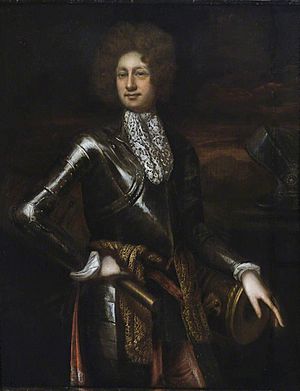William Stewart, 1st Viscount Mountjoy facts for kids
Quick facts for kids
William Stewart
|
|
|---|---|
| Viscount Mountjoy | |
 |
|
| Born | 1650 or 1653 |
| Died | 3 August 1692 Battle of Steenkerque |
| Spouse(s) | Mary Coote |
| Issue | William and Charles |
| Father | Alexander Stewart, 2nd Baronet, of Ramelton |
William Stewart, 1st Viscount Mountjoy (born 1653, died 1692) was an important soldier from Ireland. He was known for his bravery and leadership.
Contents
Early Life
William Stewart was born in 1653. His father was Sir Alexander Stewart. William's family came from Donegal, a region in Ireland. They were of Scottish background and were Protestant.
Military Career
William Stewart became a high-ranking officer in the army. He was put in charge of the artillery (cannons) and led a group of soldiers. In 1682, King Charles II gave him the special titles of Viscount Mountjoy and Baron Stewart. These titles made him a member of the Irish nobility.
Serving in Hungary
In 1686, Mountjoy joined a group of European armies called the Holy League. He fought in Hungary during the Siege of Buda. This was a big battle to take back the city of Buda. William was seriously hurt twice during this fight.
Return to Ireland
When he came back to Ireland, he was promoted to brigadier-general. A famous writer named Macaulay described him as "a brave soldier, an accomplished scholar." In Dublin, William Stewart was part of a group of smart people. They formed a "Royal Society" to discuss new ideas.
Political Changes in Ireland
In 1685, King Charles II died, and his brother, James II, became king. King James II started replacing Protestant officials in Ireland with Catholic ones. In 1687, he chose Richard Talbot to be his main representative in Ireland.
In 1688, King James II asked for Irish soldiers to help defend England. Many troops left Ireland. To replace them, Tyrconnell decided to create four new regiments. One of these was for the Ulster region. It was led by the Earl of Antrim, a Catholic nobleman. He hired 1,200 Scottish soldiers who were all Catholic.
The Siege of Derry
In 1688, William Stewart was in charge of the army in Derry. During the Glorious Revolution, many Protestants supported Prince William of Orange. However, Mountjoy remained loyal to King James II. Even so, Tyrconnell did not fully trust Mountjoy. He wanted to put more reliable troops in Derry.
On November 23, 1688, Tyrconnell ordered Mountjoy to go to Dublin. Then, the Earl of Antrim was sent to take over Derry. But when Antrim arrived on December 7, the city gates were closed by 13 young apprentice boys. This event started the Protestant uprising in Ulster.
Tyrconnell then sent Mountjoy back to Derry. On December 21, Mountjoy made a deal with the city leaders. Two companies of his soldiers, who were all Protestant, were allowed into the city. Mountjoy became the governor of Derry, but he soon let Robert Lundy take over this role.
Imprisonment in France
Despite his success, Tyrconnell wanted to get rid of Mountjoy. He asked him to go on a special trip to France with Stephen Rice. Mountjoy agreed, and they left on January 10, 1689. However, Rice had secret letters from Tyrconnell for the King of France, Louis XIV. These letters suggested that Mountjoy should be arrested.
Because of this, William Stewart was thrown into the Bastille prison in France. He stayed there until 1692. While he was in prison, the Irish Parliament passed a law against him and many others. This law demanded that Stewart report to Dublin for punishment. It even said he had to break out of the Bastille to do so!
Final Battle
In April 1692, Mountjoy was set free in exchange for another officer, Richard Hamilton. After his release, he changed his loyalty and joined King William's army. He became a general in Flanders. William Stewart died fighting bravely at the Battle of Steenkerque on August 3, 1692.
Family Life
William Stewart married Mary Coote. She was the daughter of Richard Coote, 1st Baron Coote. They had six sons and two daughters.
Their children included:
- William Stewart, 2nd Viscount Mountjoy (1675–1728): He was their oldest son and inherited his father's title.
- Alexander Stewart: He had one daughter named Anne.
- Mary Stewart (around 1677–1765): She married twice. Her first husband was Phineas Preston. After he died, she married Vice Admiral George Forbes, 3rd Earl of Granard.
- Jane Preston (around 1690–1746): Mary's daughter from her first marriage. She married Alexander Breckenridge.
- Catherine Stewart: She married Arthur Davys, who was a Member of Parliament in Ireland.
- Charles Stewart (1681–1741): He became an officer in the Royal Navy and also a Member of Parliament.
When William Stewart died in 1692, his title of Viscount Mountjoy went to his eldest son, William.
Through his eldest son William, he was the grandfather of nine children. These included William Stewart, 1st Earl of Blessington and 3rd Viscount Mountjoy. Through his daughter Mary, he was the grandfather of Jane Preston, who married Alexander Breckenridge. He was also the grandfather of George Forbes, 4th Earl of Granard.

